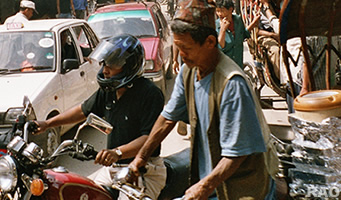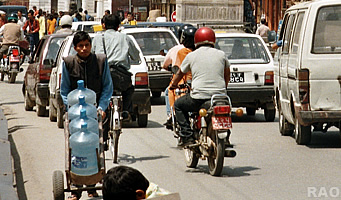|
'Inevitable'
Himalayan earthquake will threaten the country
|
 |
Nepal's
Nature Earthquakes |
|
|
 |
|
Nepal's tragedy in waiting
|
 |
Margareta Wahlstrom, UN Secretary-General's Special Representative for Disaster Risk Reduction in discussion with Robert Piper, UN Resident Coordinator, Nepal, at the two day UN High Level retreat convened by UNISDR to work on a strategic plan of action for disaster risk reduction and resilience for the UN.
By Denis McClean
It's a scenario from hell which could rival the 2010 Haitian earthquake in terms of human losses.
Conservative estimates are that the next big earthquake could result in 100,000 dead, 200,000 injured and one to two million people displaced in the fabled Kathmandu Valley where memories live on of the 1934 earthquake which took more than 8,000 lives.
One indicator of how well prepared landlocked Nepal is for such a calamity is the fact that the Kathmandu valley has a grand total of seven fire engines to call on, often in serious disrepair. India is donating 17 more soon that will be distributed across the country.
Nobody has ever retrofitted a hospital in Nepal to make it earthquake proof and until five years ago retrofitting schools was proceeding at a snail's pace of no more than five per year.
Now every school in the Kathmandu Valley is being assessed and over the course of 2012 65 school buildings are being retrofitted. Funds are in place for 260 more to be retrofitted by the end of 2014 but the overall target is 980 school buildings.
At the same time, WHO and the Ministry of Health is conducting a detailed assessment of 60 hospitals; 20 will be selected for detailed structural assessments and, finally, ten hospitals will be presented to donors next year for retrofitting. If not upgraded they will collapse in any repetition of the 1934 disaster.
Other major progress is that 82 sites have been identified to provide shelter for the earthquake displaced and now the challenge is to supply these sites with water. The country may still lack a National Disaster Management Agency but 71 of Nepal's 75 districts have now finalized disaster preparedness and response plans.
Robert Piper, the UN Resident and Humanitarian Coordinator in Nepal, told a UN High Level Retreat on Disaster Risk Reduction this week in Paris, "it's a race against time to save as many lives as possible before Nepal faces its next large scale disaster. That is why we have put together the Nepal Risk Reduction Consortium (NRRC) which is moving ahead with five flagship programmes in line with the Hyogo Framework for Action, focusing on safe schools and hospitals, flood risk management, community-based disaster preparedness and strengthening policy and institutions.">
Mr. Piper painted a vivid picture of the situation in Nepal to provide food for thought to representatives of 20 UN agencies convened by UNISDR at UNESCO HQ in Paris for two days to work on the development of a strategic UN action plan for disaster risk reduction and resilience.
Without downplaying the enormity of the overall challenge, he outlined the positive work being done by the consortium across its five flagship areas. In addition to the progress being made on hospitals and schools, a flood forecasting and meteorology service will be launched next year. Four years ago the Kosi River flooded and displaced 60,000 families in Nepal and over two million across the border in India.
The Nepal Red Cross and the International Federation of Red Cross and Red Crescent Societies are working with a coalition of local and international NGOs which has developed some 500 community-based disaster preparedness projects with common characteristics ensuring a more coherent approach to risk reduction across the country.
UNDP is taking the lead on improving land use policy and the training of masons to lessen the impact of a future earthquake. "Policies and institutions are important. It's the buildings which will kill people not the earthquake. So Nepal needs the necessary policies and institutions to enforce the building code." The establishment of a national disaster management authority is another priority the Consortium is working on with the Government.
Commenting on the overall approach taken by the consortium, he said: "We are focused on keeping it real. We are promoting practical life-saving measures which anyone can understand. The donors are supportive and so are the major financial institutions including the World Bank's Global Facility for Disaster Reduction and Recovery and the Asian Development Bank. Annual spending on disaster risk reduction in Nepal has grown from barely $8 million five years ago to a projected $40 million in 2013. There is not a lot of new development money coming in -- rather, we are using existing resources better.">
While the Nepal Consortium approach might not be replicable everywhere there were lessons to be learned such as being selective in programming and realistic in time-lines. He also said that the convening power of the UN, and the combination of the Resident Coordinator and UNISDR roles were key factors in the successes achieved to date.
As a general point, he also suggested that the humanitarian agencies could manage their exit strategies more effectively "to make it less likely they will have to return in two or three years time" by investing significantly in disaster risk reduction before closing down humanitarian operations in disaster affected countries.
The Nepal Risk Reduction Consortium comprises the United Nations, ECHO, Australian Aid, UK Aid, the Government of Japan, World Bank/GFDRR, the Asian Development Bank, the International Federation of Red Cross and Red Crescent Societies and the United States Government. The consortium works in partnership with the Government of Nepal and key ministries.
 |
| Source:
United Nations Office for Disaster Risk Reduction - Regional Office for Asia and Pacific (UNISDR AP), November 2012 |
|
Links
|
 |
 |
 |
External
link |
|






